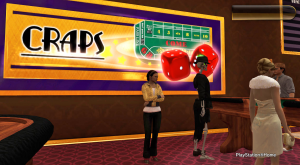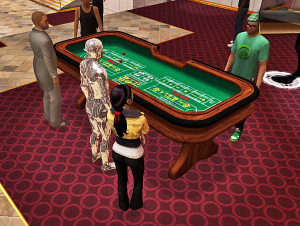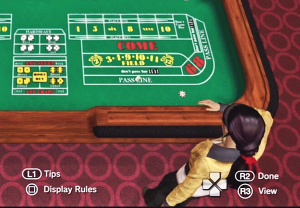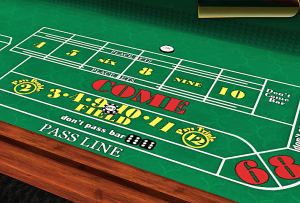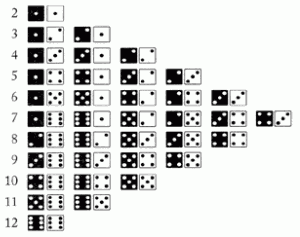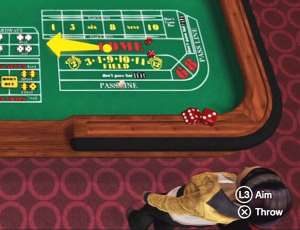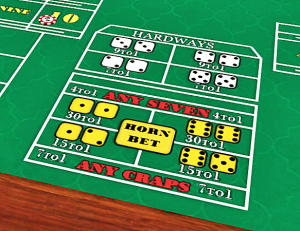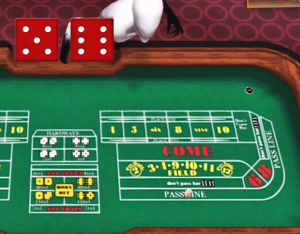Craps comes to Paradise Springs
by SealWyf, HSM Editor
Digital Leisure continues to expand its Paradise Springs inventory with games that replicate the real casino experience. The new Craps tables, which share a room with Blackjack, are a very welcome addition. Craps is wildly popular in real casinos, and, with conservative play, the odds are quite acceptable. You can keep your money working for a long time, and have a lot of fun riding the wild swings of luck. And there’s always a chance you’ll walk away a major winner.
Home had a craps-like game in the Ooblag’s Alien Casino, now defunct. The Ooblag game was a sort of “craps lite,” with sci-fi styling and simplified rules. But what Digital Leisure now offers us is the real thing, or as close as one can come to it in a virtual environment.
Craps can be intimidating if you have not played it before. The table is covered with spaces for placing bets, marked with arcane labels such as “Pass Line” and “Come”. Not all bets are available at all times. And the real-life game is not for the shy and retiring, because all players have the chance to be the “shooter” — the center of attention, and the focus of praise or scorn depending on the success of your turn at the dice.
If you are not familiar with craps already, I strongly suggest you study the game before investing heavily in the Paradise Springs version. You can read one of the many “for beginners” books on gambling, or study the rules on the web. On many online craps sites, you can practice playing for free. When you play at the Paradise Springs Casino, real money is involved, although it has been translated into virtual chips. But these can vanish quickly, so it pays to have your betting skills in order.
Studying is important, because craps is not a simple game. In complexity, it lies between slots (pull the lever and see if you won anything) and video poker, where you must evaluate many different factors to know the proper way to play a hand.
The Digital Leisure craps table includes extensive help screens. You can view them by hitting the Square button, or get “tips” on a particular bet by pressing L1 while your puck is on the space. However, this can be a frustrating way to study, because you are bumped out of the help screens as soon as the dice are rolled. And, if you have not already placed a bet, you are bumped out of the game as well. It would be nice if Digital Leisure made these screens available in a form where you not hurried or distracted, such as a special “tutorial table.”
What follows is a rough summary of conservative play that will keep your bankroll from vanishing like a magician’s pretty assistant.
A turn starts when a new shooter receives the dice. In a real casino, the craps dealers would shout “New shooter!” In Home, there are no dealers, so you simply have to be aware of what is going on. That shooter will continue to hold the dice until they lose their turn by “sevening out” and the dice are passed to the next player.
The first roll of a game is called the “come out” roll. Bets are placed in preparation for it, mostly on the Pass and Don’t Pass lines. (Betting “Don’t Pass” may be resented in real casinos, because you are betting against the shooter. But don’t let that stop you. It’s a good bet.)
After all bets are on the board, the shooter rolls the dice and the dealer calls out the result. If two, three or twelve are rolled, that’s “craps”. The Pass bets lose and the Don’t Pass bets win. If seven or eleven (“yo-leven!”) are rolled, the Pass bets win and the Don’t Pass bets lose. All Pass and Don’t Pass bets pay even money — they double your bet.
If four, five, six, eight, nine or ten are rolled, a “point number” has been established. The “point” is marked with a puck on the playing field. Now the shooter attempts to roll the point number a second time before rolling a seven, which is called “sevening out”. And that’s where the fun really starts. More bets are placed on the layout, and enthusiasm builds.
You’ll notice that seven is a winning number on the come-out roll, and a losing number once the point has been established. There is a good reason for this.
Consider for a moment how dice are constructed — cubes with sides labeled one through six. You might assume that any number is equally likely to be rolled, and this is true for a single die. But once you have two of them, things change. The chart below shows the possible combinations of two six-sided dice. You’ll see that there is only one way to roll a two (“snake eyes”) and a twelve (“boxcars”). But there are six combinations that make a seven. This means that seven is the easiest number to throw. It is rewarded on the come-out roll, but penalized when a point number must be repeated. This is how the casino makes its money.
So now the shooter is rolling to repeat the point number. What are he and the other players doing with their bets? Simply waiting for the point number to repeat can get boring, and it’s not the way to make a lot of money. So once the point is established, you’ll probably be placing some other bets on the layout.
The best bet you can make, statistically speaking, is adding “odds” to your Pass Line bet. You do this by placing a separate stack of chips behind the main bet.
The advantage of odds is that, while the Pass Line bet pays even money (1:1) regardless of the point, the “odds” pay at the true probability of a particular point number hitting. Odds on six or eight pay 6:5, odds on five or nine pay 3:2, and odds on four or ten pay 2:1. The number of chips you can add for odds also varies, keeping the maximum odds payout at six times the base bet.
When you weight your total bet with “odds”, craps approaches an even-money game, a true statistical coin-flip. This is why it’s one of the best games in the casino for a smart, patient player. I recommend you make the minimum Pass Line bet (10 chips), and add the maximum odds to it once the point number is established.
If you want more action, you can also make a “Come” bet, by placing a bet in the large section of the board labeled “Come” after the point number has been established. This is in effect a new Pass Line bet, and it pays the same. If a two, three or twelve appears on the next roll, it’s “craps” and the bet is lost. If a seven or 11 is rolled, the bet wins even money. If any other number is rolled, the bet is moved into the appropriate numbered square on the layout and waits to be repeated. If the shooter rolls that number again before rolling a seven, your bet wins. And you can choose to add odds to your Come bet, if you wish.
Note that a seven clears off the board — all bets lose, except bets that were in the Come area, or the appropriate “Don’t” bets. This is why it’s important to play cautiously. I try to keep a Pass Line bet and two Come bets active. If you have a hot shooter — one who rolls a lot a numbers without sevening out — you can make a lot of money with this strategy, cashing in on repeating numbers. But you can lose a lot of money if your shooter is cold. It’s these wild swings of fortune that makes craps an exciting game.
In the real world, there are shooters who can control the dice with such skill that they are always hot, and are viewed with suspicion by casino executives. In the virtual world of Home, dice rolls are being simulated by a random number generator. While you still have streaks of wins or losses, what you are seeing is probability, not skill. But it’s still exciting when a shooter is rolling a lot of numbers, and you are raking in the virtual chips. And it’s very pleasing when the hot shooter is you.
There are other bets, of course — quite a lot of them, ranging from the okay to the statistically ugly. This is why I suggest you study the game and its probabilities before risking significant amounts of cash on it. You should definitely stay away from the “proposition bets” in the center of the table, and the large yellow “Field” bet on each side. These pay well if you hit, but not well enough to make up for the fact that they almost always lose. However, some of these “ugly” bets are tied to rewards in the Paradise Springs Casino, so if you are a completist, you’ll need to attempt them. But if you can live a full and productive life without a pair of dollar-sign glasses, you should avoid those lossy, sucker bets.
In my experience, the game is still a bit buggy. It can take several attempts to join — sometimes you seem to have joined the game, but it will not let you place a bet, and you are booted from the table as soon as the roll starts. I assume these are the normal growing pains of going into production, and the game will become more reliable as the code is adjusted. Like all server-intensive Home games, it is also vulnerable to lag.
Aside from these issues, I like the feel of the game. The controller rumbles when it’s your turn to shoot, and the mechanics of shooting (tip the left stick to aim, press X to release the dice) are satisfying and intuitive, and give the illusion you actually have some control over the roll.
Placing bets is simple as well, once you get used to the controls. You move your puck to the proper square with the d-pad, then hit X to place a bet, and adjust the bet amount with a dialog. You can also adjust a bet later, just like a real craps game, or take the bet down if you are feeling nervous about it.
The total bet at risk at any given time is limited to 200 chips. This feels artificially low to me, but if you keep your individual base bets at ten chips, you can still have a lot of “action.”
Action is the heart of craps. When you have a hot shooter, you want to get a lot of chips on the layout, collecting wins every time he repeats a number. It’s why the game is so exciting in real casinos, and why it’s important to find a table with a low minimum bet.
Two-dollar craps in Vegas can be great fun, but the higher Atlantic City minimums (usually ten, fifteen or even 25 dollars) make the game unplayable for someone with my bankroll. Because it’s not just the minimum bet you are making — it’s the minimum bet plus the odds, plus the Come bets and their odds. And that adds up fast.
That is why it’s fun to have craps, real craps, available in Home’s casino. I can have much of the excitement of the real casino game, the thrilling swings of fortune, and the satisfaction of a long, productive turn at the dice, without actually risking my rent money. Judging by the response I’ve been seeing from other players, and the crowds at the virtual tables, Digital Leisure has another winner on its hands.
See you at the tables!


